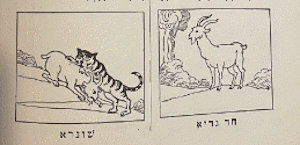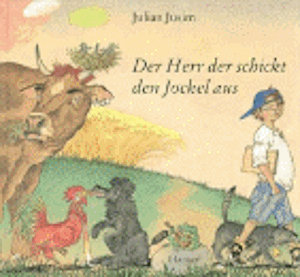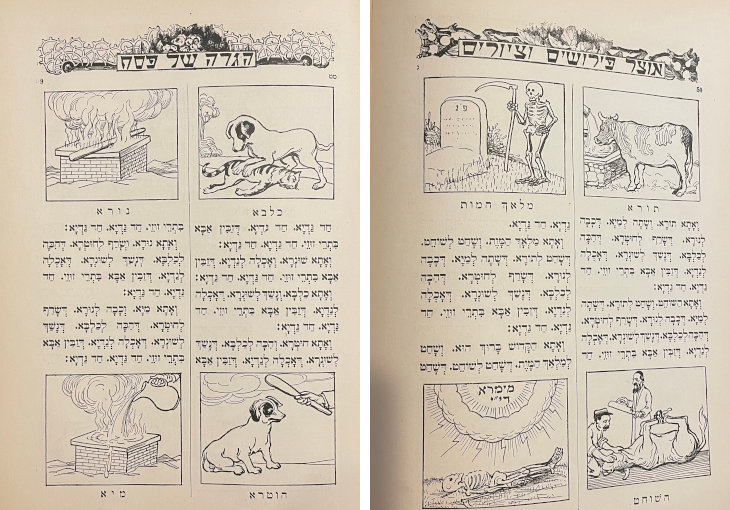 Identifying as a Jew
Identifying as a Jew


5 min read
The likely inspiration for the famous Passover poem is a medieval German children’s rhyme.
There’s too much similarity between Chad Gadya – the apparently simple but deceptively complex song at the end of the Passover Haggadah – and some late medieval German folk rhymes to be coincidental. The question is, which one came first? Was Chad Gadya created as a Jewish adaptation of a European children’s rhyme, or vice versa?
 Chad Gadya illustrations by Lola (Leon Israel) from the J.D. Eisenstein Haggadah (New York, 1920)
Chad Gadya illustrations by Lola (Leon Israel) from the J.D. Eisenstein Haggadah (New York, 1920)
The fact that Chad Gadya is written in Aramaic, a language that European Jews had abandoned as a spoken language centuries earlier, supports the notion that it was older than any German doggerel. The absence of the Chad Gadya from early Sephardic and Yemenite Haggadahs, however, and the few early handwritten versions that survived the middle ages, suggest that it was probably adapted from a German original by a 14th century Ashkenazic Jew, possibly a refugee from the great expulsion of French Jews in 1306.
What value did that anonymous Jewish wordsmith see in the ephemeral words of a children’s fairy tale, to transform it into the profound classic that drew the attention of commentators like the towering Rabbi Elijah of Vilnius, the Vilna Gaon (1720-1797)?
Folklorist Uriel Ofer pointed out that Chad Gadya is hardly unique, as similar limericks are identified in stories from Japan, Greece, Russia and elsewhere. In the English language, this type of children’s story is best exemplified by “The Old Lady who Swallowed a Fly,” in which an unfortunate octogenarian swallows successively larger and less plausible creatures in an attempt to root out the offending insect.
 Cover of a contemporary version of the medieval German poem, Amazon.com, 1996.
Cover of a contemporary version of the medieval German poem, Amazon.com, 1996.
In the case of Chad Gadya, the likely inspiration for the poem is a medieval German children’s rhyme called “The Foreman that Sent Jockel Out,” which young Jockel (pronounced “Yokel,” which also captures some of the connotations of the word in English), the foreman of a feudal manor sends out the lazy young man to cut oats, a tedious and repetitive task. Jockel, apparently the son of the lord of the manor, regards this task as beneath his dignity, and refuses to obey. The foreman responds by sending a peasant to roust Jockel out, but the peasant also refuses, so the foreman sends a dog to bite the hand of the peasant. Now it begins to sound a bit more like Chad Gadya – a stick is sent to beat the dog, fire to burn the stick, water to put out the fire, an ox to drink the water, and a butcher to slaughter the ox, but all refuse the task. Some Teutonic weirdness follows: a vulture is sent for the butcher, a witch for the vulture, and a hangman for the witch, until finally the foreman alerts the lord of the manor, who threatens the hangman into action, which motivates the witch to chase away the vulture, all the way down to Jockel who rushes out to do his duty and cut the oats.
The first major difference between Jockel and Chad Gadya – after we remove the vulture, the witch, and the hangman – is the primary message of the story. In the German version, the rhyme is a cautionary tale for a lazy child of privilege, and affirms the power structure of the patriarchal feudal economy. The takeaway message is “do what you’re told without delay, or else you’ll get in trouble.”
Chad Gadya, on the other hand, presents a completely different message in an ordered universe: the helpless little goat, a thinly veiled reference to the Jewish people, is antagonized as the victims of a hierarchy of villains, but God will redress all grievances and redeem the Jewish people in the Messianic Era. The overall message is that even the suffering of the least of creatures is significant, and no temporal power can withstand the power of God, who will one day redress all wrongs.

The second major difference is the deep philosophical meaning that Jews have derived from the sequence of events in the song, everything from the experience of the soul to the unfolding of world history. The latter, of course is my favorite, with each of the figures (cat, dog, stick, etc.) representing a different period of the Jewish experience of history.
Bottom line: don’t be fooled by the apparently simple children’s rhyme, with its close association to other fables and stories. There is some deep, historical Jewish wisdom in Chad Gadya.
|
Chad Gadya |
Conqueror |
Period |
Notes |
|
Little goat |
N/a (the Jewish people) |
The Exodus |
Entry into the Land of Israel |
|
Two Zuzim |
N/a (Moses and Aharon) |
||
|
Cat |
Assyria |
Late 8th c. BCE |
Conquest of the northern Kingdom of Israel, exile of the northern tribes |
|
Dog |
Babylonia |
Early 6th c. BCE |
Conquest of the southern Kingdom of Judah, exile of Judah and Benjamin |
|
Stick |
Persia |
Late 6th c. BCE |
Establishment of Persian province of Yehud in the Land of Israel |
|
Fire |
Greece |
322 BCE |
Alexander the Great of Macedon conquers the Land of Israel |
|
Water |
Rome |
63 BCE |
Pompey enters the Land of Israel and asserts Roman authority |
|
Ox |
Mecca |
636 CE |
Islam expands to the west, and after a brief struggle, seizes the Land of Israel |
|
Shochet |
Europe |
1095 CE |
The first of several Crusades results in the periodic displacement of Muslims from Israel |
|
Angel of Death |
Turks |
12th c. CE |
Muslims retake Israel in a series of battles, later incorporated into the Ottoman Empire based in Turkey until 1917 |
|
The Holy One who is Blessed |
Us? Israel? |
The Messianic Period |
Are we in the footsteps of the Messianic era now? |
A version of this article appeared in the Young Israel of Lawrence-Cedarhurst Community Haggadah.

These type of poems or parables are common. I see no similarity in the stories of Hagadya and the German story.
My favorite, "For Want of a Nail..."